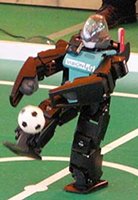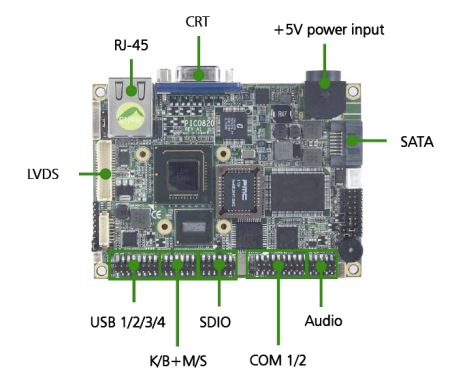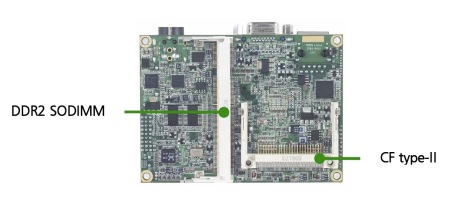Autonomous robot runs Linux on Intel Atom
Oct 5, 2009 — by LinuxDevices Staff — from the LinuxDevices Archive — 5 viewsVstone has announced a two-legged humanoid robot that sports an onboard, Intel Atom-based PC. The “Robovie-PC” can walk on joints that offer six degrees of freedom, offers an accelerometer and gyro sensors, includes a 1.3 megapixel webcam, and has a body padded with polyurethane foam, says the company.
 According to Vstone, the Robovie-PC incorporates much of the same technology as the company's Vision4G (right), known for its participation in the RoboCup, a yearly soccer competition for autonomous robots. Slightly shorter than the Vision4G (15.3 rather than 17.51 inches), the Robovie-PC is appropriate for high-end hobbyists and research applications, the company says.
According to Vstone, the Robovie-PC incorporates much of the same technology as the company's Vision4G (right), known for its participation in the RoboCup, a yearly soccer competition for autonomous robots. Slightly shorter than the Vision4G (15.3 rather than 17.51 inches), the Robovie-PC is appropriate for high-end hobbyists and research applications, the company says.
The Robovie-PC includes foot, knee, and ankle joints using "gear interlock parallel link" mechanisms, and offering six degrees of freedom. The robot can walk with "excellent stability," Vistone says, though in case it falls over, the device is protected by polyurethane knee, torso, and shoulder padding.

Vstone's Robovie-PC
The Robovie-PC (above) also has a 1.3 megapixel webcam for vision, a three-axis accelerometer, and a two-axis gyro, says Vstone. Optional equipment, meanwhile, is said to include hands designed to grip objects, with a small servo mechanism to prevent overload, plus an additional elbow servo that allows the robot's arms to move more freely.
Vstone says the Robovie-PC's standard complement of 20 servomotors is controlled by a VS-RC003-HV "sub-CPU", an ARM7-based processor that is clocked at 60MHz and was also used on the Vision4G. The main CPU, however, is an Intel Atom Z530, provided to the robot through its use of Axiomtek's PICO820 SBC (single board computer), pictured below.

Axiomtek's PICO820 has real-world RJ45, VGA, and SATA connectors
The PICO820 offers a RJ45 connector for gigabit Ethernet, a VGA output, a 5VDC power input, and an SATA port. Additional interfaces, supplied via pin headers, include four USB ports, SDIO, PS/2 style keyboard/mouse, audio I/O, and two serial ports, according to Axiomtek.

The rear of the PICO820 has SODIMM and CompactFlash connectors
On the reverse of the board (above), the PICO820 has a single 200-pin SODIMM socket, supporting up to 1GB of DDR2 RAM. The board also has a Type II CompactFlash slot, says Axiomtek.
Naturally, it would be undesirable for the Robovie-PC to have to trail wires behind itself at all times. Vstone says the robot is available with optional, USB-interfaced wireless LAN or 3G WLAN cards, and can operate for an unspecified amount of time on an internal, 2000mAh battery. According to Vstone, the Robovie-PC measures 15.3 x 8.85 x 4.52 inches (390 x 225 x 115mm) and weighs 4.96 pounds (2.2kg), including battery.
The Robovie-PC
Source: Vstone via PlasticPals.com
(click to play)
Availability
According to Vstone, the Robovie-PC is available now, supporting Linux, Windows XP, and Windows Vista. Pricing is set at 400,000 Japanese Yen (approximately $4,450). The gripping hands add 18,900 Yen ($210) to the price, and additional elbow servos are 12,600 Yen ($140).
More information may be found on the Vstone website, here, and the company's online store, here.
This article was originally published on LinuxDevices.com and has been donated to the open source community by QuinStreet Inc. Please visit LinuxToday.com for up-to-date news and articles about Linux and open source.